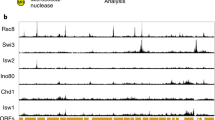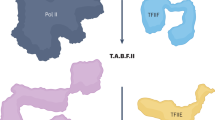Abstract
In eukaryotes, transcriptional activators have been proposed to function by recruiting the RNA polymerase II (Pol II) machinery1,2,3, by altering the conformation of this machinery4,5, or by affecting steps after initiation6,7,8, but the evidence is not definitive. Genomic footprinting of yeast TATA-box elements reveals activator-dependent alterations of chromatin structure9 and activator-independent protection10, but little is known about the association of specific components of the Pol II machinery with promoters in vivo. Here we analyse TATA-box-binding-protein (TBP) occupancy of 30 yeast promoters in vivo. We find that TBP association with promoters is stimulated by activators and inhibited by the Cyc8–Tup1 repressor, and that transcriptional activity correlates strongly with the degree of TBP occupancy. In a small subset of promoters, TBP occupancy is higher than expected when gene activity is low, and the activator-dependent increase is modest. TBP association depends on the PolII holoenzyme component Srb4, but not on the Kin28 subunit of the transcription factor TFIIH, even though both proteins aregenerally required for transcription. Thus in yeast cells, TBP association with promoters occurs in concert with the Pol II holoenzyme, activator-dependent recruitment of the Pol II machinery occurs at the vast majority of promoters, and Kin28 acts after the initial recruitment.
This is a preview of subscription content, access via your institution
Access options
Subscribe to this journal
Receive 51 print issues and online access
$199.00 per year
only $3.90 per issue
Buy this article
- Purchase on Springer Link
- Instant access to full article PDF
Prices may be subject to local taxes which are calculated during checkout





Similar content being viewed by others
References
Ptashne, M. & Gann, A. Transcriptional activation by recruitment. Nature 386, 569–577 (1997).
Klein, C. & Struhl, K. Increased recruitment of TATA-binding protein to the promoter by transcriptional activation domains in vivo. Science 266, 280–282 (1994).
Keaveney, M. & Struhl, K. Activator-mediated recruitment of the RNA polymerase II machinery is the predominant mechanism for transcriptional activation in yeast. Mol. Cell 1, 917–924 (1998).
Roberts, S. G. & Green, M. R. Activator-induced conformational change in general transcription factor TFIIB. Nature 371, 717–720 (1994).
Chi, T. & Carey, M. Assembly of the isomerized TFIIA-TFIID-TATA ternary complex is necessary and sufficient for gene activation. Genes Dev. 10, 2540–2550 (1996).
Rougvie, A. E. & Lis, J. T. Postinitiation transcriptional control in Drosophila melanogaster. Mol. Cell. Biol. 10, 6041–6045 (1990).
Yankulov, K., Blau, J., Purton, T., Roberts, S. & Bentley, D. L. Transcriptional elongation by RNA polymerase II is stimulated by transactivators. Cell 77, 749–759 (1994).
Krumm, A., Hickey, L. B. & Groudine, M. Promoter-proximal pausing of RNA polymerase II defines a general rate-limiting step after transcription initiation. Genes Dev. 9, 559–572 (1995).
Selleck, S. B. & Majors, J. Photofootprinting in vivo detects transcription-dependent changes in yeast TATA boxes. Nature 325, 173–177 (1987).
Chen, J., Ding, M. & Pederson, D. S. Binding of TFIID to the CYC1 TATA boxes in yeast occurs independently of upstream activating sequences. Proc. Natl Acad. Sci. USA 91, 11909–11913 (1994).
Strahl-Bolsinger, S., Heckt, A., Luo, K. & Grunstein, M. SIR2 and SIR4 interactions differ in core and extended telomeric heterochromatin in yeast. Genes Dev. 11, 83–93 (1997).
Aparicio, O. M., Weinstein, D. M. & Bell, S. P. Components and dynamics of DNA replication complexes in S. cerevisiae : redistribution of MCM proteins and Cdc45p during S phase. Cell 91, 59–69 (1997).
Meluh, P. B. & Koshland, D. Budding yeast centromere composition and assembly as revealed by invivo cross-linking. Genes Dev. 11, 3401–3412 (1997).
Blaiseau, P. L. & Thomas, D. Multiple transcriptional activation complexes tether the yeast activator Met4 to DNA. EMBO J. 17, 6327–6336 (1998).
Keleher, C. A., Redd, M. J., Schultz, J., Carlson, M. & Johnson, A. D. Ssn6-Tup1 is a general repressor of transcription in yeast. Cell 68, 709–719 (1992).
Tzamarias, D. & Struhl, K. Functional dissection of the yeast Cyc8–Tup1 transcriptional co-repressor complex. Nature 369, 758–761 (1994).
Patikoglou, G. & Burley, S. K. Eukaryotic transcription factor–DNA complexes. Annu. Rev. Biophys. Biomol. Struct. 26, 289–325 (1997).
Thompson, C. M. & Young, R. A. General requirement for RNA polymerase II holoenzymes in vivo. Proc. Natl Acad. Sci. USA 92, 4587–4590 (1995).
Nonet, M., Scafe, C., Sexton, J. & Young, R. Eucaryotic RNA polymerase conditional mutant that rapidly ceases mRNA synthesis. Mol. Cell. Biol. 7, 1602–1611 (1987).
Cismowski, M., Laff, G., Soloman, M. & Reed, S. KIN28 encodes a C-terminal domain kinase that controls mRNA transcription in Saccharomyces cerevisiae but lacks cyclin-dependent kinase-activating kinase (CAK) activity. Mol. Cell. Biol. 15, 2983–2992 (1995).
Hengartner, C. J. et al. Temporal regulation of RNA polymerase II by Srb10 and Kin28 cyclin-dependent kinases. Mol. Cell 2, 43–53 (1998).
Orphanides, G., Lagrange, T. & Reinberg, D. The general initiation factors of RNA polymerase II. Genes Dev. 10, 2657–2683 (1996).
Koleske, A. J. & Young, R. A. An RNA polymerase II holoenzyme responsive to activators. Nature 368, 466–469 (1994).
Kim, Y.-J., Bjorklund, S., Li, Y., Sayre, M. H. & Kornberg, R. D. Amultiprotein mediator of transcriptional activation and its interaction with the C-terminal repeat domain of RNA polymerase II. Cell 77, 599–608 (1994).
Stargell, L. A. & Struhl, K. Anew class of activation-defective TATA-binding protein mutants: Evidence for two steps of transcriptional activation in vivo. Mol. Cell. Biol. 16, 4456–4464 (1996).
Akhtar, A., Faye, G. & Bentley, D. L. Distinct activated and non-activated RNA polymerase II complexes in yeast. EMBO J. 15, 4654–4664 (1996).
Gonzalez-Couto, E., Klages, N. & Strubin, M. Synergistic and promoter-selective activation of transcription by recruitment of TFIID and TFIIB. Proc. Natl Acad. Sci. USA 94, 8036–8041 (1997).
Cormack, B. P., Strubin, M., Ponticelli, A. S. & Struhl, K. Functional differences between yeast and human TFIID are localized to the highly conserved region. Cell 65, 341–348 (1991).
Acknowledgements
We thank M. Benson, J. Geisberg, M. Harrison and S. Reed for DNAs and yeast strains; L. Stargell for TBP antibodies; M. Green for communicating unpublished results; and O. Aparicio, S. Bell and J. Lis for discussion. This work was supported by postdoctoral fellowships to L.K. from the Association pour la Recherche sur le Cancer and the Human Frontier Science Program, and by research grants to K.S. from the NIH.
Author information
Authors and Affiliations
Corresponding author
Rights and permissions
About this article
Cite this article
Kuras, L., Struhl, K. Binding of TBP to promoters in vivo is stimulated by activators and requires Pol II holoenzyme. Nature 399, 609–613 (1999). https://doi.org/10.1038/21239
Received:
Accepted:
Issue Date:
DOI: https://doi.org/10.1038/21239
This article is cited by
-
The Mediator kinase module enhances polymerase activity to regulate transcriptional memory after heat stress in Arabidopsis
The EMBO Journal (2024)
-
Molecular mechanisms by which the HIV-1 latent reservoir is established and therapeutic strategies for its elimination
Archives of Virology (2023)
-
Universal promoter scanning by Pol II during transcription initiation in Saccharomyces cerevisiae
Genome Biology (2020)
-
Transcription regulation by the Mediator complex
Nature Reviews Molecular Cell Biology (2018)
-
Functional characterization of open chromatin in bidirectional promoters of rice
Scientific Reports (2016)
Comments
By submitting a comment you agree to abide by our Terms and Community Guidelines. If you find something abusive or that does not comply with our terms or guidelines please flag it as inappropriate.



